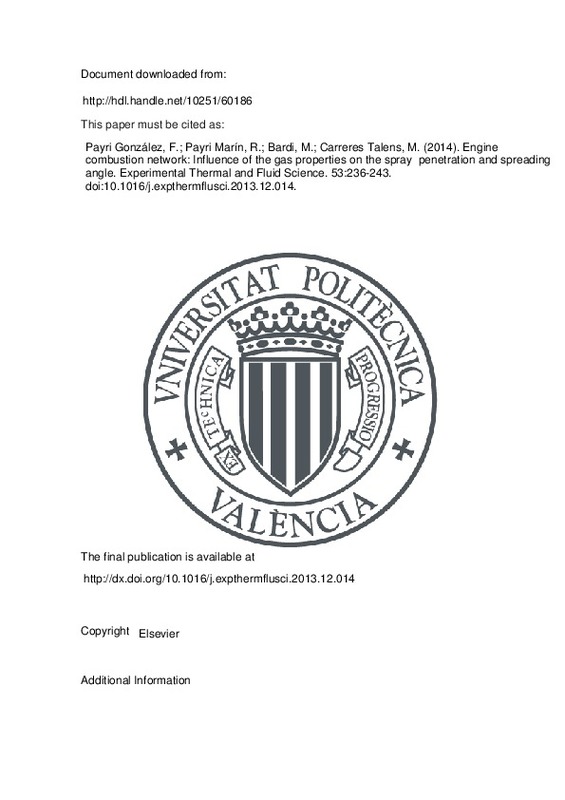JavaScript is disabled for your browser. Some features of this site may not work without it.
Buscar en RiuNet
Listar
Mi cuenta
Estadísticas
Ayuda RiuNet
Admin. UPV
Engine combustion network: Influence of the gas properties on the spray penetration and spreading angle
Mostrar el registro sencillo del ítem
Ficheros en el ítem
| dc.contributor.author | Payri González, Francisco
|
es_ES |
| dc.contributor.author | Payri Marín, Raúl
|
es_ES |
| dc.contributor.author | Bardi, Michele
|
es_ES |
| dc.contributor.author | Carreres Talens, Marcos
|
es_ES |
| dc.date.accessioned | 2016-01-26T13:19:50Z | |
| dc.date.available | 2016-01-26T13:19:50Z | |
| dc.date.issued | 2014-02 | |
| dc.identifier.issn | 0894-1777 | |
| dc.identifier.uri | http://hdl.handle.net/10251/60186 | |
| dc.description.abstract | In this work, three Engine Combustion Network (ECN) single-hole nozzles with the same nominal characteristics have been tested under a wide range of conditions measuring spray penetration and spreading angle. n-Dodecane has been injected in non-evaporative conditions at different injection pressures ranging from 50 to 150 MPa and several levels of ambient densities from 7.6 to 22.8 kg/m(3). Nitrogen and Sulphur Hexafluoride (SF6) atmospheres have been explored and, in the first case, a temperature sweep from 300 to 550 K at constant gas density has been executed. Mie scattering has been used as the optical technique by employing a fast camera, whereas image processing has been performed through a home-built Mat lab code. Differences in spray penetration related to spray orifice diameter, spreading angle and start of injection transient have been found for the three injectors. Significant differences have been obtained when changing the ambient gas, whereas ambient temperature hardly affects the spray characteristics up to 400 K. However, a reduction in penetration has been observed beyond this point, mainly due to the sensitivity limitation of the technique as fuel evaporation becomes important. The different behavior observed when injecting in different gases could be explained due to the incomplete momentum transfer between spray droplets and entrained gas, together with the fact that there is an important change in speed of sound for the different gases, which affects the initial stage of the injection. (C) 2014 Elsevier Inc. All rights reserved. | es_ES |
| dc.description.sponsorship | This work was sponsored by "Ministerio de Economia y Competitividad" of the Spanish Government in the frame of the Project "Comprension de la influencia de combustibles no convencionales en el proceso de injeccion y combustion tipo diesel", Reference TRA2012-36932. | en_EN |
| dc.language | Inglés | es_ES |
| dc.publisher | Elsevier | es_ES |
| dc.relation.ispartof | Experimental Thermal and Fluid Science | es_ES |
| dc.rights | Reserva de todos los derechos | es_ES |
| dc.subject | Diesel injection | es_ES |
| dc.subject | Spray | es_ES |
| dc.subject | Spray characteristics | es_ES |
| dc.subject | Engine combustion network | es_ES |
| dc.subject.classification | INGENIERIA AEROESPACIAL | es_ES |
| dc.subject.classification | MAQUINAS Y MOTORES TERMICOS | es_ES |
| dc.title | Engine combustion network: Influence of the gas properties on the spray penetration and spreading angle | es_ES |
| dc.type | Artículo | es_ES |
| dc.identifier.doi | 10.1016/j.expthermflusci.2013.12.014 | |
| dc.relation.projectID | info:eu-repo/grantAgreement/MINECO//TRA2012-36932/ES/COMPRENSION DE LA INFLUENCIA DE COMBUSTIBLES NO CONVENCIONALES EN EL PROCESO DE INYECCION Y COMBUSTION TIPO DIESEL/ | es_ES |
| dc.rights.accessRights | Abierto | es_ES |
| dc.contributor.affiliation | Universitat Politècnica de València. Departamento de Máquinas y Motores Térmicos - Departament de Màquines i Motors Tèrmics | es_ES |
| dc.contributor.affiliation | Universitat Politècnica de València. Instituto Universitario CMT-Motores Térmicos - Institut Universitari CMT-Motors Tèrmics | es_ES |
| dc.description.bibliographicCitation | Payri González, F.; Payri Marín, R.; Bardi, M.; Carreres Talens, M. (2014). Engine combustion network: Influence of the gas properties on the spray penetration and spreading angle. Experimental Thermal and Fluid Science. 53:236-243. https://doi.org/10.1016/j.expthermflusci.2013.12.014 | es_ES |
| dc.description.accrualMethod | S | es_ES |
| dc.relation.publisherversion | http://dx.doi.org/10.1016/j.expthermflusci.2013.12.014 | es_ES |
| dc.description.upvformatpinicio | 236 | es_ES |
| dc.description.upvformatpfin | 243 | es_ES |
| dc.type.version | info:eu-repo/semantics/publishedVersion | es_ES |
| dc.description.volume | 53 | es_ES |
| dc.relation.senia | 265517 | es_ES |
| dc.contributor.funder | Ministerio de Economía y Competitividad | es_ES |







![[Cerrado]](/themes/UPV/images/candado.png)

